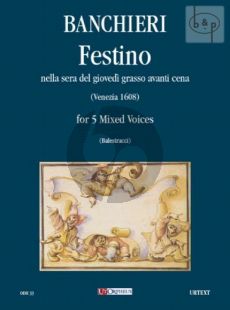Il Festino nella sera del giovedi grasso avanti cena by Adriano Banchieri (1568-1634) was published in Venice by Ricciardo Amadino in 1608 in five part books (Canto, Canto II, Alto, Tenore, Basso) without a score, as was customary. It is one of the most famous commedie armoniche or commedie madrigalesche or again comedie musicali, as it is referred to in the preface to Orazio Vecchi's Amfiparnaso (1597). This genre enjoyed a certain popularity at the end of the sixteenth and into the third decade of the seventeenth century: Alessandro Striggio's Il cicalamento delle donne al bucato (1567) is usually cited as the first example, followed by works by Giovanni Croce, Orazio Vecchi and of course Banchieri. It is surely significant that these three musicians were all churchmen, for whom writing profane works must have been something of a diversion. It was a matter of producing straightforward, light-hearted entertainment, featuring settings not of the courtly, love-laden verses of the poets prized by the madrigalists of the day (Tasso, Guarini, Petrarca) but of lyrics they themselves composed or by minor provincial authors such as the Emilian Giulio Cesare Croce, famous for the adventures of Bertoldo. Commedie armoniche comprise a sequence of polyphonic pieces which may include madrigals but can also feature the villanella, giustiniana, moresca, canzonetta, intermezzo or simply free compositions rendering the comic spirit of an episode, frequently dance music with words added. Some of these comedies (like Banchieri's La Pazzia senile, 1598) have a story line linking one episode to another (in this case the love, first obstructed and then crowned with success, of the young couple Fulvio and Doralice, set against the senile concupiscence of Pantalone, duly mocked by the courtesan Lauretta), while others simply consist in a series of discrete cameos presenting particular situations or characters (as in Vecchi's Selva di varia ricreatione, 1590). In any case all are obviously a musical derivation of the commedia dell'arte, with the standard figures of the latter (Pantalone, Arlecchino, Dottor Graziano, the loving couple, the Spanish captain, and so on) recurring frequently. However, the commedia armonica was not intended to be staged, as is made quite clear in the prologue to the Amfiparnaso: à this show I am speaking of is enjoyed in the mind's eye, being perceived through the ears and not the eyes. We can imagine a group of people gathering in a small, exclusive venue to sing these comic works either for their own enjoyment or to entertain a handful of friends who could conjure up the situations evoked by the songs in the mind's eye. It was in fact a civilised way of passing an evening amongst friends, as is made explicit in the title of a comedy composed by Orazio Vecchi in 1604, Le Veglie di Siena, comprising games, imitations and other pastimes all set to music.
Banchieri's Festino presupposes a get together during the last days of carnival, actually before supper rather than in the evening, and in this case the musical diversions culminate in much hilarity around the dinner table. In the printed edition the introduction features an illustration showing an actor on stage and a view of streets and buildings in the background, with spectators crowding round the stage; the prologue to the Amfiparnaso has a very similar illustration. The guests, meaning the imagined spectators, are welcomed by the figure of Modern Entertainment, and the contrast with Antique Rigour neatly represents Banchieri's propensity for the novel, light-hearted and eccentric as opposed to anything pedantic or aridly academic. We can recall that his Concerti ecclesiastici, 1595, was the first printed work to include the part of basso continuo, while he looked for inspiration to such original musical minds as Gesualdo, Viadana and Monteverdi. At the same time, however, these were the years in which accompanied monody was asserting itself, and with it the new genre of the melodramma, offering great flexibility and potential for characterisation on stage, since the characters could now be played by individual singers. For all his modernity, Banchieri did not take this direction. In the commedia armonica, in which a character was rendered by a polyphonic structure in three or five parts, it is impossible to create a scene with a character who sings his own text (although, as we have said, this was not the goal of these compositions).
In a world in which television has largely done away with the simple pleasures of an evening amongst friends, the question of how to perform these works has to be met with solutions that come as close as possible to the spirit of the composer.






